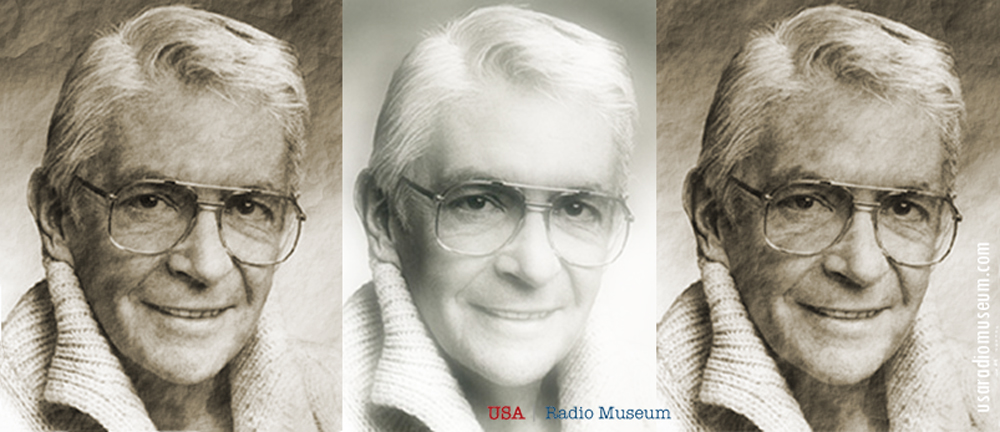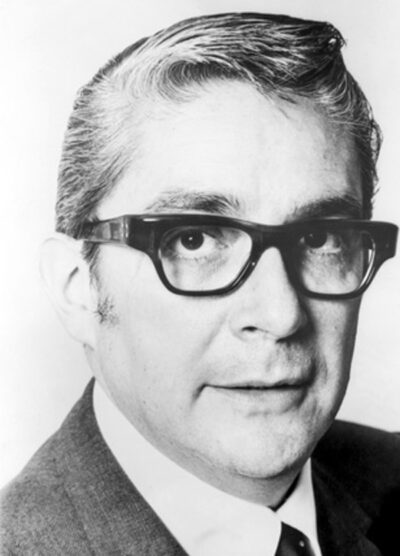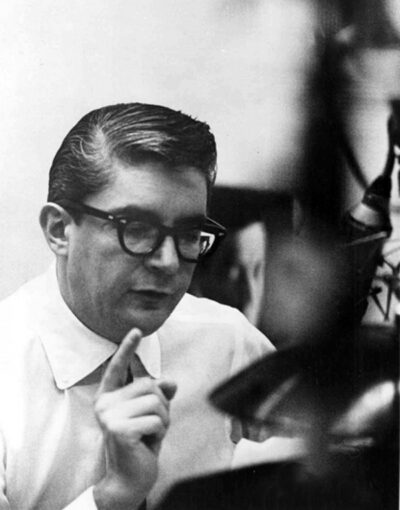William B. Williams: The Voice of New York Radio In the golden glow of mid-20th century broadcasting, few voices resonated with the warmth, ele
William B. Williams: The Voice of New York Radio
In the golden glow of mid-20th century broadcasting, few voices resonated with the warmth, elegance, and authority of William B. Williams. Known to millions simply as “Willie B.”, he wasn’t just a disc jockey—he was a cultural curator, a tastemaker, and a trusted companion to generations of New Yorkers. For over four decades, his voice drifted through the airwaves of WNEW 1130 AM, transforming the daily ritual of radio listening into something intimate, stylish, and deeply human.
Born William Breitbard on August 6, 1923, in Babylon, Long Island, Williams’ path to radio was as serendipitous as it was fated. In 1944, while visiting a friend at WAAT in Newark, he was offered a job on the spot to replace a DJ who had been fired mid-shift. That impromptu debut launched a career that would span more than 12,000 broadcasts and redefine the role of the radio personality.
Williams’ signature program, Make Believe Ballroom, became a sanctuary for lovers of American standards. With his trademark greeting—“Hello, world”—he welcomed listeners into a world of lush orchestrations, velvet-voiced crooners, and behind-the-scenes anecdotes that only he could deliver. He didn’t just play records; he told stories, offered context, and elevated the music with reverence and charm.
But perhaps his most enduring legacy lies in the way he shaped the public personas of the artists he admired. It was Williams who dubbed Frank Sinatra “The Chairman of the Board”, a moniker that stuck like a perfectly tailored tuxedo. He gave us “The Count” (Basie), “The Duke” (Ellington), “Lady Day” (Billie Holiday), and “Pops” (Louis Armstrong)—nicknames that became part of the American musical lexicon.
A quiet, dignified man off the mic, Williams brought grace and generosity to everything he touched—from hosting telethons to mentoring young broadcasters. When he passed away on August 3, 1986, just days shy of his 63rd birthday, New York City mourned as if it had lost a dear friend. Six city blocks outside Riverside Chapel filled with mourners—cab drivers, Rockettes, musicians, and everyday fans—paying tribute to the man who had been the city’s soundtrack.
William B. Williams wasn’t just a voice on the radio. He was the voice of New York—dignified, refreshing, and true to his devoted following.
Make Believe Ballroom: A Theater of the Mind and Heart
When William B. Williams took the reins of Make Believe Ballroom in 1957, he wasn’t just inheriting a radio program—he was stepping into a legacy. Originally created by Martin Block in 1935, the show was a pioneering concept: a “ballroom” of the imagination where listeners could envision themselves dancing to the finest orchestras and vocalists of the day. But under Williams’ stewardship, it became something more—a sanctuary of style, sentiment, and storytelling.
Williams opened each broadcast with his signature greeting: “Hello, world.” It was simple, universal, and instantly intimate. From that moment, listeners were transported—not just to a ballroom, but to a place where music was revered, artists were honored, and every record had a soul.
He often referred to himself playfully as “Guilliermo B. Guilliermos” or “Wolfgang B. Wolfgang,” but to his audience, he was always just Willie B. With a voice like aged bourbon and a delivery as smooth as satin, he curated each show with care, blending big band classics, jazz standards, and contemporary crooners into a seamless, sentimental journey.
What set Williams apart wasn’t just his impeccable taste—it was his storytelling. He didn’t just play Sinatra or Ella or Nat King Cole; he told you where they were when they recorded the track, what they were feeling, and how the song fit into their lives. He offered behind-the-scenes glimpses, personal memories, and historical context that made each tune feel like a rediscovered treasure.
By the mid-1960s, Make Believe Ballroom was more than a radio show—it was a cultural institution. Williams was earning $105,000 a year, the highest salary at WNEW at the time. His influence extended beyond the studio: he helped shape the public personas of the artists he played, coining nicknames like “The Chairman of the Board” for Sinatra and “The Count” for Basie.
Though WNEW briefly dropped the program in 1972, public demand brought it back in 1979—with Williams once again at the helm. The revival was hailed as a return to “an oasis of style and taste,” and it continued until his passing in 1986.
Make Believe Ballroom wasn’t just a show—it was a mood, a memory, a moment in time that never truly faded. And with Willie B. at the microphone, it became a masterclass in how to make radio feel like home.
Before the Ballroom: The Red Socks Detour
Before he became the voice of elegance at WNEW, William B. Williams had a brief detour that’s become part of New York radio folklore.
In 1944, while visiting a friend at WAAT in Newark, Williams was offered a job on the spot to replace a DJ who had just been fired. Six weeks later, his rich delivery caught the ear of a WNEW staffer, and he was hired—marking the beginning of a legendary broadcasting chapter.
But in 1947, the suave announcer was briefly fired from WNEW—not for a vocal misstep, but for wearing a pair of bright red socks to the studio. Management considered it unprofessional. That brief, colorful rebellion led him to a short stint at other stations, including WOR, before WNEW welcomed him back in 1953.
From that point on, the bond between Williams and WNEW became unbreakable. And the socks? They became part of radio legend.
The Chairman and the Curator: William B. Williams & Frank Sinatra
When William B. Williams dubbed Frank Sinatra “The Chairman of the Board,” he wasn’t just handing out a catchy nickname—he was recognizing a seismic shift in American music. Sinatra had evolved from the skinny crooner of the bobby-soxer era into a commanding, self-directed artist who ran his own label and called his own shots. Williams, with his impeccable ear and instinct for cultural resonance, captured that transformation in a single phrase. And it stuck.
Their relationship began in the 1940s, when Sinatra was still singing live on WNEW for $18.75 a week. Williams, then a young announcer, was already captivated by Sinatra’s phrasing and emotional depth. Over time, their paths crossed repeatedly—on air, backstage, and in the smoky lounges of New York and Las Vegas.
Williams didn’t just play Sinatra’s records—he championed them. Even during the early 1950s, when Sinatra’s career hit a rough patch and many stations dropped him from rotation, Williams kept the faith. He continued spinning Sinatra’s songs on Make Believe Ballroom, offering context and commentary that reminded listeners why the man mattered.
That loyalty didn’t go unnoticed. Sinatra often credited Williams with helping to revive his career during those lean years. When the singer roared back with From Here to Eternity and a string of Capitol Records masterpieces, Williams was right there, narrating the comeback in real time.
In later years, Sinatra would frequently invite Williams to serve as emcee for his Las Vegas shows, a role that spoke volumes about the trust and admiration between them. Their rapport was effortless—Williams brought class and gravitas to the stage, setting the tone before Sinatra even sang a note.
According to friends and colleagues, the nickname actually began as a cheeky backstage joke—“Chairman of the Broads”—a nod to Sinatra’s legendary popularity with women. But as both men matured, the moniker was refined into something more dignified: “Chairman of the Board.”
When Williams passed away in 1986, Sinatra didn’t just send flowers—he made sure the world knew what Willie B. meant to him. He had already paid tribute at a Friars Club roast in 1984, delivering a heartfelt salute to his friend and champion.
Their story is a masterclass in how radio and recording artists once elevated each other—how a voice behind the mic could shape the legacy of a voice behind the music.
William B. Williams | WNEW | Frank Sinatra Interview | April 1986
Audio Digitally Remastered by USA Radio Museum
Speaking Truth in a Time of Scandal: Willie B. & the Payola Era
In 1959, as the American radio industry faced a reckoning over the payola scandal—where DJs were exposed for accepting bribes to play certain records—William B. Williams stood tall as a voice of integrity. While many broadcasters ducked the spotlight, Williams stepped forward in the November 30, 1959 issue of Life magazine, contributing to a bold exposé titled “Gimme, Gimme, Gimme on the Old Payola.” The piece featured insights from DJs like Ed McKenzie, Dick Whittinghill, Bob Clayton, and Williams himself, offering a rare, behind-the-scenes look at the pressures and temptations facing radio hosts during that turbulent time.
In the article’s section “A Deejay’s Exposé and Views of the Trade,” Williams offered a rare, honest look into the pressures facing radio hosts. He didn’t just condemn the practice—he contextualized it, explaining how commercialism had begun to erode the trust between DJs and their audiences. His words weren’t defensive or self-righteous—they were thoughtful, measured, and deeply rooted in his belief that music deserved respect, not manipulation.
By speaking out, Williams reinforced what his listeners already knew: his taste couldn’t be bought, and his voice couldn’t be swayed. In an era when credibility was collapsing, he became a beacon of trust—cementing his legacy not just as a radio voice, but as a moral compass for the industry.
“The audience deserves more than a playlist—it deserves honesty.”
— William B. Williams, Life, 1959
The Willie B. Effect
William B. Williams didn’t just host a radio show—he transformed what a broadcaster could be. His legacy stretches beyond playlists and call letters; it lives in the tone, taste, and trust that today’s audio personalities still strive to emulate.
From NPR’s jazz curators to modern podcast hosts who speak directly to their listeners with warmth and wit, the DNA of Willie B.’s delivery is everywhere. His effortless blend of reverence for music, rich storytelling, and genuine intimacy helped redefine radio as a relationship—not just a transmission.
And for those who came after—like Scott Regen, Vin Scelsa, or any DJ who ever cracked a mic hoping to offer something deeper than “just the next track”—The Willie B. Effect was both blueprint and beacon. His voice may have signed off in 1986, but the way he spoke still echoes in how the best in broadcasting connect with their audience whether yesterday, or today.
Legacy Spotlight: Scott Regen – Inspired by Willie B.
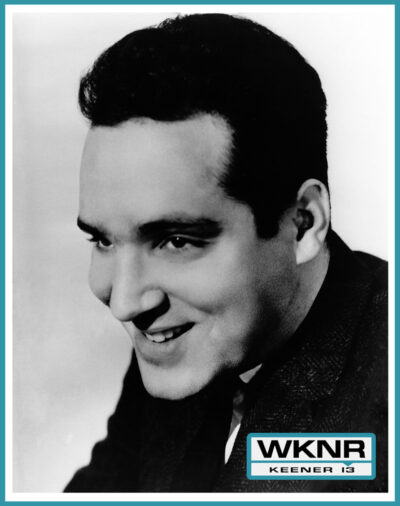 Long before he became Detroit’s number one nighttime DJ at WKNR, Scott Regen was a kid named Robert Bernstein growing up in Brooklyn, glued to the dial, listening to WNEW’s Make Believe Ballroom. His hero? William B. Williams.
Long before he became Detroit’s number one nighttime DJ at WKNR, Scott Regen was a kid named Robert Bernstein growing up in Brooklyn, glued to the dial, listening to WNEW’s Make Believe Ballroom. His hero? William B. Williams.
As Regen later shared, hearing Williams on the radio wasn’t just entertaining—it was transformative. “I didn’t know voices could sound like that—so personal, so real. I wanted to do that. I wanted to be that.” At just 14, Regen visited WNEW and watched Willie B. broadcast live. That moment lit the spark that would define Regen’s life.
With charisma and presence of his own, Regen went on to dominate Detroit airwaves in the 1960s under the Keener 13 banner, where he hosted interviews with the Beatles, and Motown legends. But throughout his rise, he never forgot his roots—or the man who made it all seem possible.
Regen often paid homage to Williams on air and in interviews, citing him as his radio father figure. He even opened his earliest broadcasts with Henri René’s “You Are the One”—the same theme song Williams used for Make Believe Ballroom—a quiet nod to the voice that first stirred his dreams.
Scott Regen didn’t just inherit the mic—he inherited the mission: to make every listener feel like the only one in the room. Just as Willie B. did.
William B. Williams | WNEW | July 4, 1975
Audio Digitally Remastered by USA Radio Museum
Honors & Recognition: The Industry’s Standing Ovation
While William B. Williams never sought the spotlight, it found him all the same—both behind the mic and on the grandest stages of radio and entertainment.
- In 1984, the prestigious Friars Club named Williams “Man of the Year,” honoring him at a glittering tribute inside New York’s Waldorf-Astoria. The master of ceremonies? None other than Frank Sinatra, who led a night of laughter, memories, and heartfelt respect for the man who’d coined his most enduring nickname.
- A year later, in 1985, the Friars Club Foundation awarded him their coveted “Applause Award,” not just for his broadcasting excellence but for his unwavering support of charitable causes. Williams lent his voice and time to organizations like the Boy Scouts of America, St. Jude Children’s Research Hospital, and Memorial Sloan-Kettering Cancer Center—quiet generosity that spoke volumes.
- Then, in 1988, two years after his passing, Williams received one of the industry’s highest posthumous honors: induction into the NAB Broadcasting Hall of Fame. A fitting tribute from the very institution his voice helped define.
Together, these accolades underscore what listeners always knew: William B. Williams wasn’t just a man with a microphone. He was the conscience of the dial. Today, whether it’s a jazz host on NPR, a vinyl enthusiast on satellite radio, or a podcaster weaving music and memoir, you can hear traces of William B. Williams. His voice may be silent, but his style still swings on radio to this day.
Six Blocks of Goodbye: New York Remembers William B. Williams
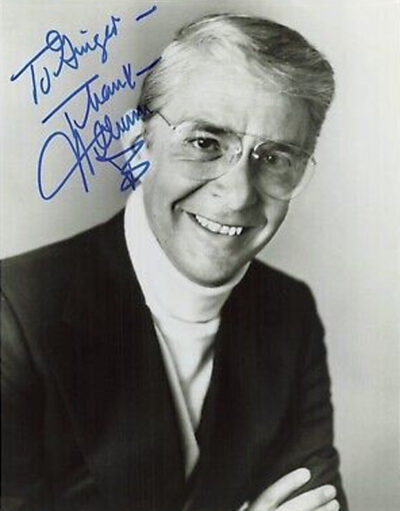 On the morning of August 5, 1986, something unthinkable happened in New York City—it paused.
On the morning of August 5, 1986, something unthinkable happened in New York City—it paused.
Two days after the passing of William B. Williams, the voice that had guided the city through four decades of melody, memory, and meaning, six blocks surrounding Manhattan’s Riverside Chapel filled to the brim. No announcement. No formal rally. Just thousands of people—taxi drivers with radios turned down low, sanitation workers leaning on their brooms, Rockettes in heels and tears, jazz musicians with trumpet cases in hand—drawn together by the gravity of grief and gratitude.
It wasn’t a fanfare. It was a farewell.
Though he had been battling respiratory failure, chronic anemia, and had recently undergone cancer surgery, many believed Williams was recovering. His death, just shy of his 63rd birthday, stunned the city.
Inside the chapel, mourners included Tony Bennett, Lena Horne, Buddy Hackett, Alan King, Julius La Rosa, Jerry Vale, Sammy Cahn and more. Outside, hundreds stood in the streets. Some carried radios. Others simply stood in silence.
William B. Williams had a family. He was married to Dottie Mack, a former singer and television personality, and they had a son named Jeffrey, who was 25 at the time of Williams’ passing. The family lived in Manhattan, and by all accounts, his home life was as grounded and gracious as his on-air persona.
“The radio didn’t sound right without him. It wasn’t just quiet—it felt hollow.”
To those six blocks and far beyond, William B. Williams was never just a disc jockey. He was a friend you hadn’t met. He was Sunday morning coffee and late-night cab rides. He was velvet, grace, and loyalty in a pinstripe suit and a velvet voice. And on that August day, the city gave him the only encore it could: collective stillness.
The Lasting Impact of William B. Williams on Broadcasting
William B. Williams didn’t just influence radio—he redefined its emotional frequency. At a time when disc jockeys were often fast-talking pitchmen or faceless voices behind the music, Williams introduced a new archetype: the companion. He brought warmth, elegance, and storytelling into the booth, creating a style that was less about spinning records and more about curating moments.
A New Standard of Taste and Trust
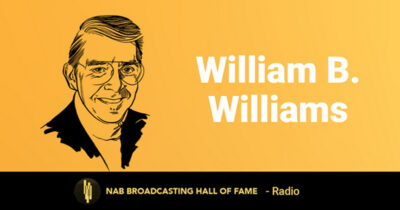 Williams treated music with reverence. He didn’t just play a Sinatra ballad—he told you where it was recorded, what the artist was going through, and why it mattered. That blend of musical knowledge and personal insight became a blueprint for generations of broadcasters. He showed that a DJ could be a trendsetter, a historian, and a friend all at once.
Williams treated music with reverence. He didn’t just play a Sinatra ballad—he told you where it was recorded, what the artist was going through, and why it mattered. That blend of musical knowledge and personal insight became a blueprint for generations of broadcasters. He showed that a DJ could be a trendsetter, a historian, and a friend all at once.
His influence is especially visible in the way modern radio and podcast hosts build intimacy with their audiences. The conversational tone, the personal anecdotes, the sense that the host is speaking just to you—that’s pure Willie B. DNA. He made the microphone feel like a fireside, not a stage.
Modern programming such as The Jonathan Schwartz Show and The American Songbook series openly channel the Make Believe Ballroom spirit. Even digital stations like WFMU or Jazz24 pay homage, consciously or not, to the blend of narrative, elegance, and musical storytelling that Williams championed.
Even the term “the Great American Songbook” gained traction thanks to voices like his who insisted those songs—and their singers—weren’t relics, but cornerstones.
A Legacy That Echoes Through Time
Williams’ impact wasn’t limited to style—it extended to substance. He coined enduring monikers like “The Chairman of the Board” for Frank Sinatra, shaping how artists were perceived by the public. He championed musicians during their low points, most notably continuing to play Sinatra’s music when others had written him off. That loyalty helped revive careers and reminded the industry of the power DJs held in shaping public taste.
He also mentored and inspired future legends like Scott Regen, who credited a teenage visit to WNEW as the moment he knew he wanted to be on the air. Regen’s own warm, personal style in Detroit radio was a direct echo of Williams’ influence.
Where the Music Sleeps
After his passing in 1986, William B. Williams was laid to rest at Kensico Cemetery in Valhalla, New York—a peaceful, tree-lined resting place just north of the city he serenaded for over four decades. Known for being the final home of many icons in the arts and entertainment world, Kensico is a fitting setting for the man whose voice became New York’s soundtrack.
Surrounded by whispering pines and gentle hills, his grave rests quietly among storytellers, singers, and performers—one last ensemble, still and eternal. Just as he gave his listeners moments of reflection and grace, this resting place now offers one in return. It’s a serene and historic resting place, also home to many notable figures from the world of entertainment and the arts—a fitting final chapter for a man whose voice became a lasting part of New York’s heart.
William B. Williams didn’t just play music—he scored the lives of millions. He gave New York City a soundtrack of elegance, empathy, and enduring taste. His voice was velvet, his presence a comfort, and his influence immeasurable.
In a world that often rushes past nuance, he reminded us to pause. To listen. To feel.
And though the ballroom may now be silent, the echo of his sign-on—“Hello, world”—still lingers in the hearts of those who tuned in, leaned back, and listened to the heartbeat of a man who made radio more than just sound—he seemed to make it larger than life itself.
William B. Williams (1923–1986)
Forever the voice of New York.
_____________________
A USARM Viewing Tip: On your mobile or tablet device? Finger-tap all the above images inside the post and stretch image across your device’s screen for LARGEST digitized view.

